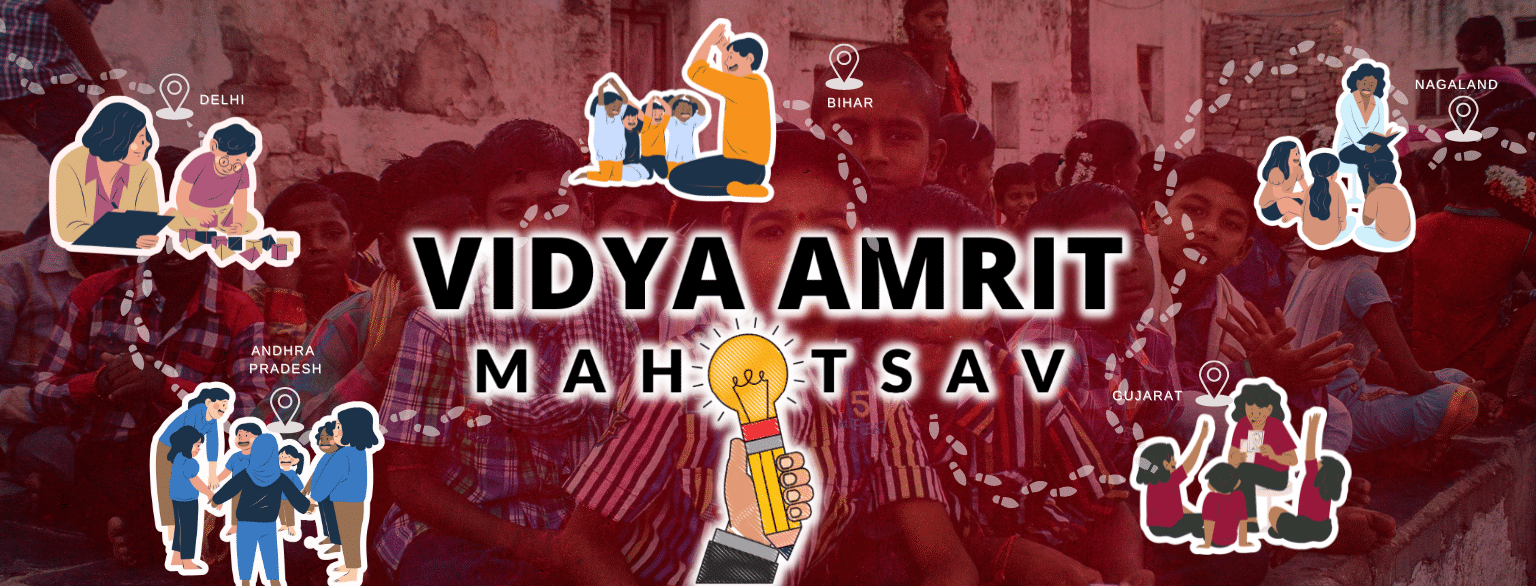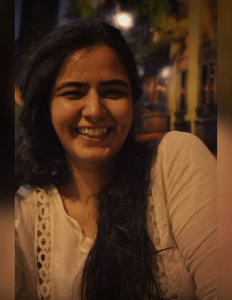
Vidya Amrit Mahotsav:
An NCERT-Ecosystem Driven Initiative Engraved in Golden Letters
The impact of continuous small steps to achieve different goals, challenges the prevailing notion that change is possible only through big steps, yielding power, or grand endeavours. Scores of people around us undertake these small steps in pursuit of a better life. Even in our classrooms, small innovations happen every day. Teachers and school leaders engage in various activities, ranging from ensuring play-based learning, usage of effective teaching-learning material (TLM), story-telling, organising reading circles, conducting interactive sessions, etc. all aimed towards enhancing student outcomes. All these aspects reflect the crucial role of taking small steps to achieve big goals and making schools a better place for learning, Thereby, creating an enriching learning environment for every child.
Following this approach of taking small steps to achieve big change in every school is commonly referred to as the ‘micro-improvement’ approach. It encourages one to break down a big idea into clear, actionable tasks in a way that suits their needs, to address any challenge in schools. From the lens of this approach, let’s take a look at the stories of two school leaders, one from Bengaluru and another from Pune.
- In Shri Vidyaniketan school in Bengaluru, post-pandemic effect was a decline in the reading level. The Headmistress (HM) of the school aimed to bridge this gap. She along with two teachers visited another school that had a library. The HM decided to set up a library by taking help from other schools. Teachers were up-skilled to manage the library, 2000 books were outsourced and reading hours were integrated into the timetable. These efforts helped the students achieve the desired reading levels.
- In PCMC English Medium School in Pune, a school leader observed that parents lacked awareness of nutrition and students ate a poor diet affecting their attention and engagement in class. The school leader onboarded school teachers, social workers and doctors to prepare a cost effective diet chart. The school invited parents to inform them about this initiative and its importance. With this, parents started sending food for their children in two tiffin boxes, one that had fruits for a short break and another that had their mid day meal, including chapati and vegetables for the longer break. These efforts helped create awareness amongst parents about nutrition levels for their children, and eventually better student outcomes.
Both these examples highlight the importance of taking small steps for solving any challenge in schools. Be it improving reading levels among students or creating awareness about nutrition amongst parents for better student outcomes. There are many such examples not just from India, but from across the globe.
Vidya Amrit Mahotsav
Vidya Amrit Mahotsav (VAM) is one such micro-improvement program that was launched by the Ministry of Education during the Shikshak Parv ‘2022. The National Council of Educational Research and Training (NCERT) supported by ShikshaLokam – an education leadership NGO, spurred the education ecosystem in India to undertake lakhs of micro-improvements under VAM, an Innovative Pedagogy Festival. It encourages, recognises and nurtures these innovations by teachers, teacher educators and school leaders.
VAM empowered individuals at all levels of the education system. It was built on the deep trust in all the teachers and school leaders and their abilities to lead improvements in their classrooms and schools. Theirs is a significant role in achieving quality education for all. Over the course of six months, from September 2022 till March 2023. VAM witnessed an overwhelming sense of enthusiasm among participants from all corners of the nation. 27 States & UTs participated in the Mahotsav and a total of 5.98 lakh projects were submitted.
Along with the enthusiastic participation of the states, a few states such as Haryana and Nagaland have also initiated their own state programs, following the micro-improvement approach. The success of the Mahotsav is evident through mass participation and substantial impact can be attributed to the roles played by each key actor, showcasing their immense promise and dedication.

A lot of valuable insights came from the reflection sessions with the NCERT officials. These insights helped to understand the program from a broader perspective and incorporate these key learnings for future programs that would be implemented at a national level.
“VAM was a success. Everyone, including the entire team at NCERT and CSOs who supported the Mahotsav, were a part of the learning process. Throughout the program, a lot of support was provided to the states in planning, and implementing the Mahotsav and the spontaneity in responding to the hurdles being faced by the states. We have made a note of all the learnings and difficulties, which will be relevant for future programs. I believe the Second Mahotsav will see even greater success with these learnings in tow.”
– Prof. Indu Kumar (National Coordinator DIKSHA)
“VAM received overwhelming adoption leaving a possibility of making it sustainable for capturing the best practices. The reports available over DIKSHA indicate healthy competition among States & UTs and motivate them to contribute and participate in this national festival. The best part of the festival has been the practice of maintaining a repository of all the best practices that were shared by teachers and school leaders across all the States & UTs. There were also some challenges that came up while implementing the program, such as the gaps in following certain processes, and a more rigorous outreach would have helped in increasing participation. Challenges of this sort are opportunities for us to learn for our future programs.”
– Mr. Arvind Gupta (National Team Lead, NDEAR DIKSHA PMU)
Micro-improvements are enabled digitally as Projects on DIKSHA – the National Infrastructure for Education by the Ministry of Education, GoI, and are available to teachers, teacher educators and school leaders on their mobile phones. Each micro-improvement on DIKSHA lends itself to a repository of best practices and innovations that other educators from across the country can discover, learn from and implement according to their needs.
Let’s hear a few voices from the states:
“Programs like VAM were much needed by the state. There is a lot of untapped talent in the teachers and school leaders of Nagaland and this enabled them to get recognised for the work they do everyday”.
– Bijano Murry (Joint Managing Director, Samagra Shiksha – Nagaland)
“The Mahotsav was effective, and the ecosystem significantly profited from it. It helped the teachers a lot with running school improvement programs and eventually positively affected the students as well.”
– Sapna Yadav (DIKSHA Coordinator, SCERT- Delhi)
These voices are a reflection of their belief in the micro-improvement approach and its potential to bring greater shifts in the system. But what made Vidya Amrit Mahotsav, the most ardently celebrated festival of the year in the education space? Let’s scroll through some core principles that the co-orchestrators & co-designers (NCERT (CIET), DIKSHA Program Management Unit (PMU) team & Civil Society Organisations like Barefoot Edu Foundation, Mantra4Change, ShikshaLokam and Vidhya Vidhai ) of the festival made a point to stick to.
Guiding Principles of Vidya Amrit Mahotsav

- Promoting Agency
States & UTs were given the choice to extensively experiment and tailor the program according to their specific needs. They had the autonomy to decide the implementation approach and evaluation methods within their regions, with NCERT offering recommended solutions. For example: Nagaland, contextualised the program to inculcate love for reading among students and launched the Nagaland Reading Festival under Vidya Amrit Mahotsav. This agency trickled down to the school leaders and teachers as well who designed the improvement projects basis the problems they wanted to solve in their classroom/ school to impact the students. - Collective Action
The festival catalysed collaboration between civil society, government, and the education stakeholders on the ground. National organisations partnered with NCERT to design the festival, provide support, and ensure program outreach. States & UTs were encouraged to work in partnerships with NGOs, resulting in 85+ NGOs collaborating across 27 States & UTs. - Technology as the backbone
This national innovation program’s success was rooted in DIKSHA’s empowering infrastructure, fostering innovation and scalability. By embracing open access, data privacy, and impactful classroom activities, it united learners and educators on a collective journey to transform the face of the education landscape. Technology widened the scope of guided innovations, encouraging teachers & school leaders to assess, plan, prioritise and lead their individual improvement journeys. - Celebration over Competition
When conceptualising Vidya Amrit Mahotsav as a festival, it aimed to evoke the spirit of celebration and co-creation rather than making it competition-driven. The program was envisioned as a collective effort for nationwide school improvements and classroom innovations. It encouraged leaders to involve their teachers, and students along with parents & community members through improvement projects. Promoting the feeling of ‘we all are in this together’ to make schools as nurturing as possible for its students.
Vidya Amrit Mahotsav was an opportunity to demonstrate that change can occur when the right conditions are created by empowering teachers and school leaders to exercise their agency.
Looking ahead, NCERT is decentralising program orchestration and design, shifting the focus to districts as the unit of change in line with NEP 2020’s vision for District Institutes of Education and Training (DIETs). The program’s versatility allows for reimagination with different themes to address various urgent concerns within the education system, such as foundational literacy and numeracy, community engagement, inclusive education and much more. And with this approach, we hope that our Indian Education System establishes a new milestone of building great schools offering quality education – a future our children rightly deserve.
Meet the Author

Bhavya Kukreja
Political science Graduate, Young India Fellow and a Development Professional who strongly believes in the power of education. A coffee lover who loves to read and learn from the experiences of others. Currently, a part of Prograns Team at Shikshalokam. Working with Central institutions and different states for various program.

Sonal Bhasin
A hopeful dreamer who prefers to breathe in a fictional world of a good book than in the real one, a designer who wishes to make the world more aesthetic, colorful and beautiful than she found it to be, and the communication lead for ShikshaLokam in pursuit of becoming a storyteller. Sonal is an education enthusiast, who has herself been teaching for over 12 years and strongly believes in the power of education, opportunity and hard work.

Bhavya Kukreja
Political science Graduate, Young India Fellow and a Development Professional who strongly believes in the power of education. A coffee lover who loves to read and learn from the experiences of others. Currently, a part of Prograns Team at Shikshalokam. Working with Central institutions and different states for various program.

Sonal Bhasin
A hopeful dreamer who prefers to breathe in a fictional world of a good book than in the real one, a designer who wishes to make the world more aesthetic, colorful and beautiful than she found it to be, and the communication lead for ShikshaLokam in pursuit of becoming a storyteller. Sonal is an education enthusiast, who has herself been teaching for over 12 years and strongly believes in the power of education, opportunity and hard work.
